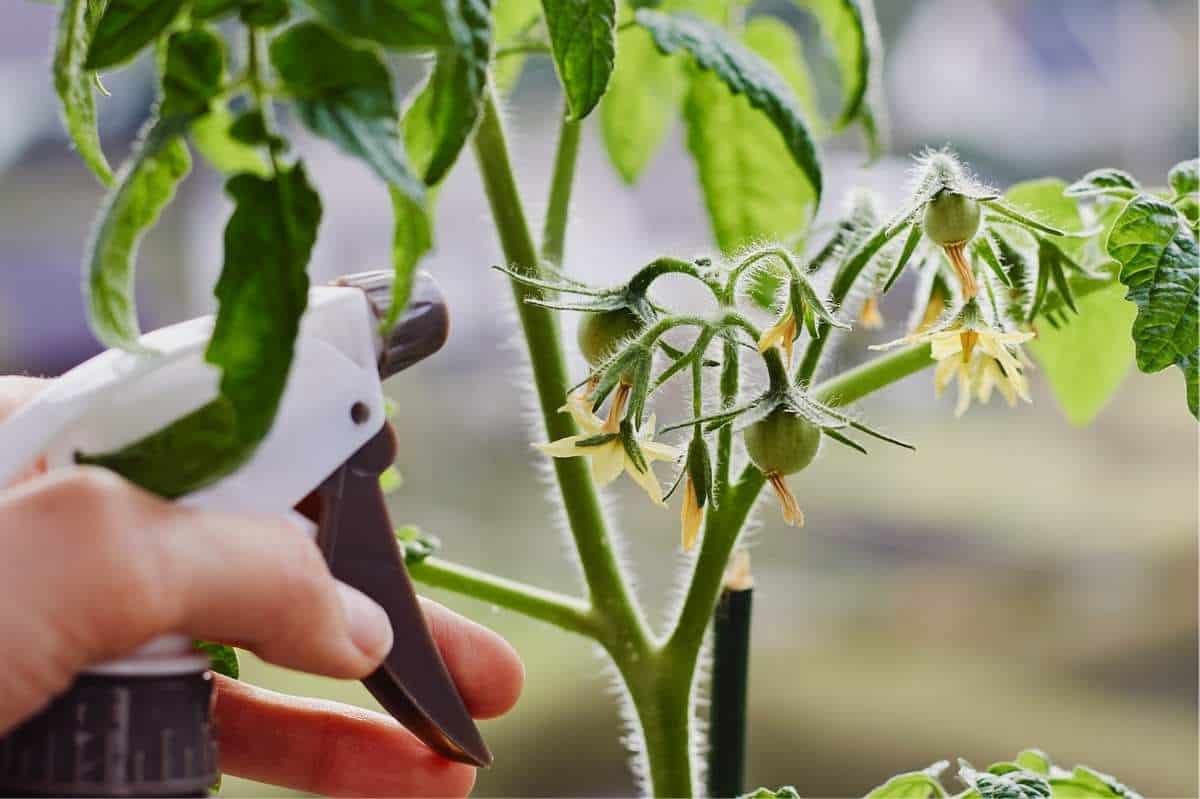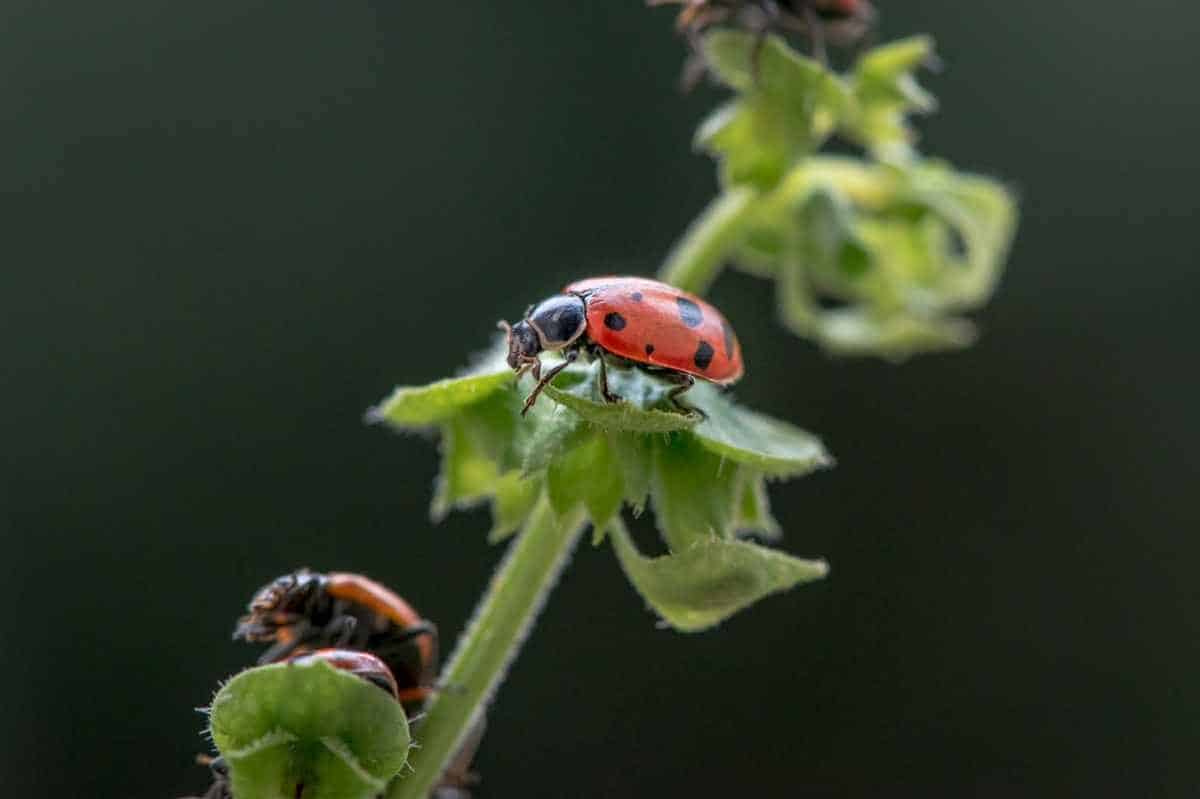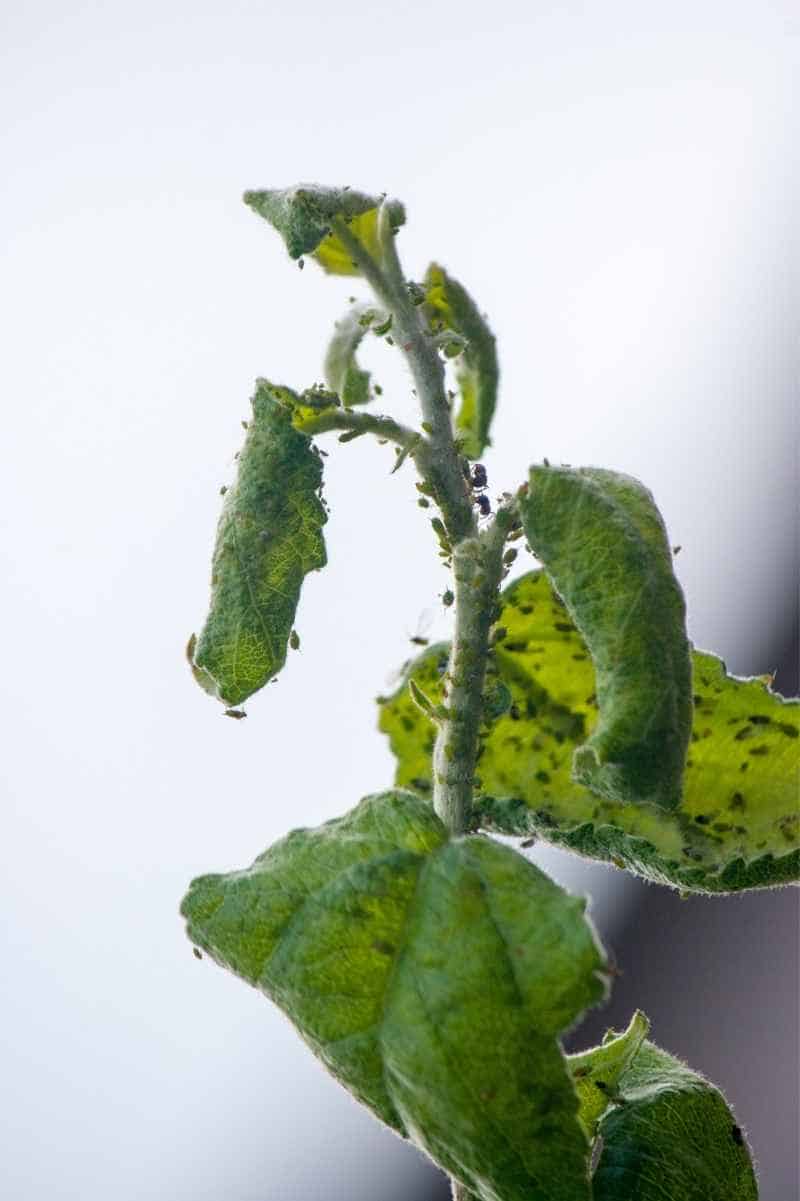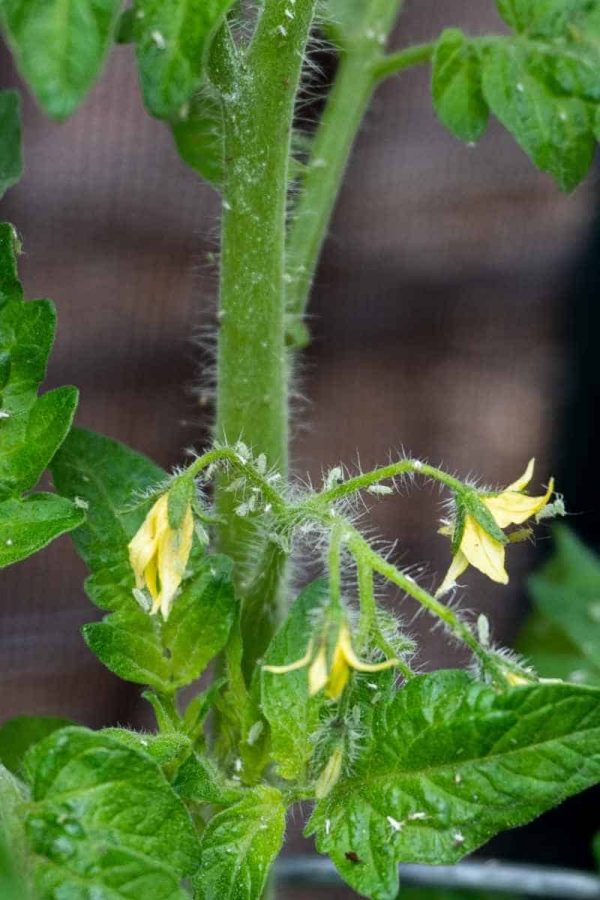If you garden for long enough, chances are, you’ll find aphids on your plants. Aphids are an incredibly common pest in the organic garden. They impact almost every plant and they can be incredibly frustrating to deal with.
Take a deep breath. We’ve got you covered. We’ve been handling aphids organically for years, and we’ve got all of our tips, tricks, and control methods for you today. Let’s send those pesky bugs packing!
Table of Contents
What Do Aphids Look Like?
Aphids are tiny bugs with soft, pear-shaped bodies. They tend to cluster on the stems and leaves of plants, which they bite into to suck out the liquids inside.
Depending on the type of aphid, they may be pale green, black, red, or yellow. On tomato plants in particular, you are most likely to see potato aphids, which tend to be pink, or green peach aphids, which tend to be pale yellow-green.

Symptoms of Aphids on Tomato Plants
Stunted leaves that are misshapen or curling around the edges are a sure sign of aphids. Because this pest sucks the sap and other nutrients out of leaves and stems, the leaves struggle to grow properly. If you suspect there is an aphid infestation, look closely at the tops and undersides of the leaves, as well as the stems. Aphids are visible to the naked eye, but they can still be pretty small, making it difficult to see them at a glance.
Another sign of an aphid infestation? Ants! Yup, aphids produce a substance called honeydew—it is clear and sticky and will coat the areas where the aphids have been. Ants are attracted to this sugary honeydew, so if you see a lot of ants on or around your tomato plants, you may have an aphid problem. The ants are larger and easier to see than the aphids, so if you see a bunch of ants, look closely to see if aphids have set up shop.
If the leaves or stems of your plants appear black, that might also be another sign. The honeydew that aphids secrete can harbor sooty mold, which tints the plants black.
Why are aphids harmful to your tomatoes?
A few aphids here or there aren’t going to wreck your garden, but when a large infestation takes over, the destruction of the soft tissues of your plants can turn terminal. In the best-case scenario, aphid damage can stunt the growth of your plants. In the worst case, aphids can kill plants by overfeeding or transmitting diseases.
Organic Methods To Get Rid Of Aphids On Tomato Plants
We are big believers in Integrative Pest Management in the Growfully Gardens, which means we use a combination of biological, chemical, cultural, and physical methods to control pest populations. Lots of layers of gentle protection lead to strong, healthy plants! We’ll talk in a bit about how we prevent aphids from taking hold in the first place, but for now, let’s walk through what we do when we first spot aphids on our plants.
Manual Removal
If you only see a few aphids, you can pick them off and drop them into a bucket of soapy water to kill them. Be sure to check the undersides of leaves, as that’s where aphids love to lurk. Check daily for new aphids to determine if you need to take another step to get rid of them.
Water Spray
If manually removing aphids icks you out or you have a lot of tomato plants, a sharp blast of water from the garden hose can knock the aphids right off the tomato leaves and stems, reducing aphid populations. Check for new aphids every few days to see if you need to spray the plants again. The one downside of this method is that water doesn’t discriminate and can also knock beneficial insects right off your plants.
Plant Bug Repellent
We make our own bug repellent for our plants with garlic, rosemary or peppermint, water, and dish soap. It is all-natural and gentle on the plants. While this spray doesn’t kill insects, it does mask the scent of their host plants (the tomatoes) so they get confused and hopefully go somewhere else!
To use this bug repellent, spray the stems, leaves, and undersides of leaves of plants. Reapply every few days until you see few to no aphids on your plants.

Water and Dish Soap
If you don’t want to make our bug repellent, you can also spray the plants with a mixture of water and dish soap. This homemade insecticidal soap works by coating the aphids and suffocating them. Make it by mixing mix a few teaspoons of liquid dish soap with one quart of water, then spray or wipe the solution onto the leaves, stems, and buds of the plant. If you have a bad infestation, you might want to go the wiping method—it’s tedious, but it will make sure you get all the aphids on all parts of the plant.
Introduce Predatory Insects
Many people will attempt to control aphid populations by introducing predatory insects such as ladybugs or lacewings to their gardens. While these insects do prey on aphids, we don’t typically recommend this route. Usually, the predatory insects you add yourself are better suited for another environment, and they will leave before controlling the aphids. Instead, we recommend using companion planting and interplanting your tomato plants with herbs and flowers that will attract the predatory insects that are native to your area. Working on having a robust beneficial insect and pollinator garden will also help you reduce all pests (not just aphids) in the long term.
Growfully Protip
Don’t forget the birds! Birds (especially small birds like hummingbirds) love to snack on a meal of aphids, so when you’re planning your garden, make sure to make your garden bird-friendly. You help them out, they’ll help you out!

Diatomaceous Earth (DE)
Diatomaceous earth (DE) is a silica-rich powder made from fossilized algae. While it doesn’t feel like much to us, to soft-bodied insects like aphids it can be deadly. The jagged edges of each grain cut into the aphids, leading them to dry up and die.
A sprinkling of DE on both the soil and the plant can help kill aphids. Be sure to select food-grade DE, which is safe for humans, instead of filter-grade DE, which is not. Diatomaceous earth doesn’t work when wet, so apply in the early morning after the dew has dried, or later in the evenings.
Growfully Protip
Growfully Tip: Do not use DE when plants are in bloom, as it can hurt pollinators like bees! If you must use DE during these times, apply it in the evening, when bees are sleeping and pollinator activity is low.
Neem Oil
Neem oil is a horticultural oil that works in a few ways—it can work similar to insecticidal soap by suffocating aphids, and it can also work as a systemic insecticide by messing with the hormone receptors in an insect. Because neem is a broad-spectrum insecticide, it is pretty much our last-resort aphid control method. While neem oil is all-natural and organic, it is also a powerful insecticide that can harm bees and other pollinators. We prefer to work on aphid infestations using other control methods.

How to Prevent Aphids on Tomato Plants
Healthy Soil and Healthy Plants
Insects prey on the weak—weak plants growing in depleted soil. One of the best things you can do to reduce insect pressure in your garden is to focus on building good soil. Healthy plants don’t succumb to the occasional bite or nibble from an aphid like weaker plants do. Good soil is the absolutely first line of pest prevention!
Companion Planting
Interplanting fragrant herbs and flowers with tomatoes can help with pest control. Plants such as basil or marigolds can mask the scent of tomatoes from aphids, protecting the fruits.
Other herbs and vegetables can attract parasitic wasps and other beneficial insects that will attack the aphids:
- Carrots
- Dill
- Cilantro
- Sage
- Parsley
- Calendula
Still other plants can repel aphids with a strong scent. These include onions, chives, and garlic.

Trap Cropping
Some flowers, such as nasturtiums, work as trap crops for aphids. Nasturtiums are more attractive to aphids than tomato plants are. Once a large number of aphids have collected on a nasturtium plant, pull and destroy the flowers to reduce the aphid population.
Sticky Traps
Aphids are attracted to the color yellow (remember our part above about insects preying on weak plants—weak plants are often yellow!), so you can purchase yellow sticky boards to trap the aphids before they make their way to your garden plants.

Attract More Aphid Predators
Grow more pollinator- and beneficial insect-attracting plants in the garden to attract aphid’s natural predators, such as lady beetles, syrphid flies, and lacewings. But don’t stop there—we also recommend setting up birdhouses and feeders near the garden to encourage birds to hang out and eat the aphids as well.









I have some tomatoes turning red that have black bottoms not all effected what do I do .
This sounds like blossom end rot. You’ll want to make sure you are watering evenly and consistently, and add calcium to the soil.